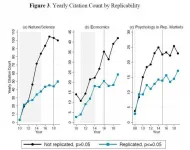Finer touch for tuning stem cell "fate" with substrates of varying stiffness
Quantitative control over localization of key proteins in mesenchymal stem cells
2021-05-22
(Press-News.org) Tokyo, Japan - Researchers from Tokyo Metropolitan University have been quantifying how different batches of mesenchymal stem cells respond to the mechanical stiffness of their environments. They focused on how certain proteins were "localized" in cell nuclei and found key trends in how this changed with stiffness. Their findings explain inconsistencies between previous findings and may guide how scientists control the state of stem cells for research and medical treatments.
Mesenchymal stem cells (MSCs) are important "progenitor" cells that can transform into muscle, cartilage, bone or fat cells. In 2006, pioneering work by Engler and coworkers showed that they could control what cell type mesenchymal stem cells transformed (or "differentiated") into by simply placing them on surfaces with a different mechanical stiffness, or elastic modulus. Ever since, scientists have been trying to identify exactly how this occurs. The trouble is, despite the phenomenon being robust and reproducible, it turns out that they are very sensitive to the exact environment into which they are placed, even which batch they came from. The stakes are high: reliable control over MSC states would mean more research and even potential biomedical applications.
This search inspired a team led by Associate Professor Hiromi Miyoshi of Tokyo Metropolitan University to look at how different batches of MSCs respond to different environments. They focused on two proteins present in MSCs, the YAP protein, which helps cells respond to mechanical environments, and RUNX2, a key player in helping MSCs turn into osteoblasts which eventually become bone. They looked at how different MSC batches have different distributions of YAP and RUNX2 inside their cells. For their "stiff" environments, they chose a specially designed gelatin substrate which had significantly better reproducibility than popular collagen alternatives.
From the beginning, they found that their batches were quite distinct. In basic experiments looking at how they turned into bone-making or fat-making cells, they found that the batches produced very different levels of calcium and fat deposits. But when it came to their mechanoresponsive behavior, it turned out they were not as wildly distinct as initially thought. Firstly, the team found that the proportion of YAP found in the nuclei of cells (or "localization") turns out to vary in a consistent manner between batches, plateauing at the same stiffness. For RUNX2, though the localization varied differently, they still plateaued at a specific stiffness value (a different one to YAP). Even then, the trend in RUNX2 localization was linear up to the plateau.
With this kind of information, anyone could make a gel of a specific stiffness and actively control the level of YAP/RUNX2 in the nucleus of mesenchymal stem cells. By doing so, they could tune when and how their cells differentiate. The team hope this new level of control over cell fate will help accelerate research into MSCs and potentially lead to therapeutic applications.
INFORMATION:
This work was supported by a JSPS KAKENHI Grant-in-Aid of Scientific Research (JP19J13048) and AMED under grant number 18gm5810012h9904.
[Attachments] See images for this press release:

ELSE PRESS RELEASES FROM THIS DATE:
2021-05-22
Nearly half a billion people on the planet have diabetes, but most of them aren't getting the kind of care that could make their lives healthier, longer and more productive, according to a new global study of data from people with the condition.
Many don't even know they have the condition.
Only 1 in 10 people with diabetes in the 55 low- and middle-income countries studied receive the type of comprehensive care that's been proven to reduce diabetes-related problems, according to the new findings published in Lancet Healthy Longevity.
That comprehensive package of care ...
2021-05-22
Business shutdowns reduce COVID-19 deaths, though with rapidly diminishing returns, with study of Italian lockdowns estimating they saved over 9,400 lives in under a month.
INFORMATION:
Article Title: Closed for business: The mortality impact of business closures during the Covid-19 pandemic
Funding: The author(s) received no specific funding for this work.
Competing Interests: The authors have declared that no competing interests exist.
Article URL: https://journals.plos.org/plosone/article?id=10.1371/journal.pone.0251373
...
2021-05-22
Plant diseases don't stop at national borders and miles of oceans don't prevent their spread, either. That's why plant disease surveillance, improved detection systems, and global predictive disease modeling are necessary to mitigate future disease outbreaks and protect the global food supply, according to a team of researchers in a new commentary published in Proceedings of the National Academy of Sciences.
The idea is to "detect these plant disease outbreak sources early and stop the spread before it becomes a pandemic," says lead-author Jean Ristaino, William Neal Reynolds Distinguished Professor of Plant Pathology at North Carolina State University. Once an epidemic occurs it is difficult to control, Ristaino says, likening the effort to the one undertaken ...
2021-05-22
Neurotic personalities found the pandemic most traumatic, while agreeable and conscientious personalities offered protection from the pandemic's negative impacts.
INFORMATION:
Article Title: Which personality traits can mitigate the impact of the pandemic? Assessment of the relationship between personality traits and traumatic events in the COVID-19 pandemic as mediated by defense mechanisms
Funding: The author(s) received no specific funding for this work.
Competing Interests: The authors have declared that no competing interests exist.
Article URL: https://journals.plos.org/plosone/article?id=10.1371/journal.pone.0251984
...
2021-05-22
Simon Fraser University researchers have validated a faster, cheaper COVID-19 test that could kickstart the expansion of more widespread rapid testing. Study results have been published in The Journal of Molecular Diagnostics.
"This research offers a cheaper, faster alternative to the most reliable and sensitive test currently used worldwide, without sacrificing sensitivity and reproducibility," says molecular biology and biochemistry professor Peter Unrau, who led the team evaluating the COVID-19 test kit.
The researchers suggest the test could be deployed in remote locations, clinics and airports due to its ease of use and portability.
The microchip real-time PCR test can provide ...
2021-05-21
To meet soaring demand for lightning-quick mobile technology, each year tech giants create faster, more powerful devices with longer-lasting battery power than previous models.
A major reason companies like Apple and Samsung can miraculously pull this off year after year is because engineers and researchers around the world are designing increasingly power-efficient microchips that still deliver high speeds.
To that end, researchers led by a team at Brigham Young University have just built the world's most power-efficient high-speed analog-to-digital converter (ADC) microchip. An ADC is a tiny piece of technology present in almost every electronic piece of equipment that converts analog ...
2021-05-21
For decades scientists have been puzzled by the formation of rare hyper-enriched gold deposits in places like Ballarat in Australia, Serra Palada in Brazil, and Red Lake in Ontario. While such deposits typically form over tens to hundreds of thousands of years, these "ultrahigh-grade" deposits can form in years, month, or even days. So how do they form so quickly?
Studying examples of these deposits from the Brucejack Mine in northwestern British Columbia, McGill Professor Anthony Williams-Jones of the Department of Earth and Planetary Sciences and PhD student Duncan McLeish have discovered that these gold deposits form much like soured milk. When milk goes sour, the butterfat particles clump together to form a jelly.
Q&A with Anthony Williams-Jones and Duncan McLeish
What did you ...
2021-05-21
A team of researchers led by scientists at UC Santa Cruz analyzed data from 3,212 camera traps to show how human disturbance could be shifting the makeup of mammal communities across North America.
The new study, published in the journal Global Change Biology, builds upon the team's prior work observing how wildlife in the Santa Cruz Mountains respond to human disturbance. Local observations, for example, have shown that species like pumas and bobcats are less likely to be active in areas where humans are present, while deer and wood rats become bolder and more active. But it's difficult to generalize findings like these across larger geographic areas because human-wildlife interactions are often regionally unique.
So, to get a continent-wide ...
2021-05-21
Free access to essential medicines increases patient adherence to taking medication by 35 per cent and reduces total health spending by an average of over $1,000 per patient per year, according to a two-year study that tested the effects of providing patients with free and convenient access to a carefully selected set of medications.
The findings, published May 21 in PLOS Medicine, come as advocates urge Canada to carve a path toward single-payer, public pharmacare. Canada is the only country with universal healthcare that does not have a universal pharmacare program.
A group of researchers led by St. Michael's Hospital of Unity Health ...
2021-05-21
Papers in leading psychology, economic and science journals that fail to replicate and therefore are less likely to be true are often the most cited papers in academic research, according to a new study by the University of California San Diego's Rady School of Management.
Published in Science Advances, the paper explores the ongoing "replication crisis" in which researchers have discovered that many findings in the fields of social sciences and medicine don't hold up when other researchers try to repeat the experiments.
The paper reveals that findings from studies that ...
LAST 30 PRESS RELEASES:
[Press-News.org] Finer touch for tuning stem cell "fate" with substrates of varying stiffness
Quantitative control over localization of key proteins in mesenchymal stem cells




